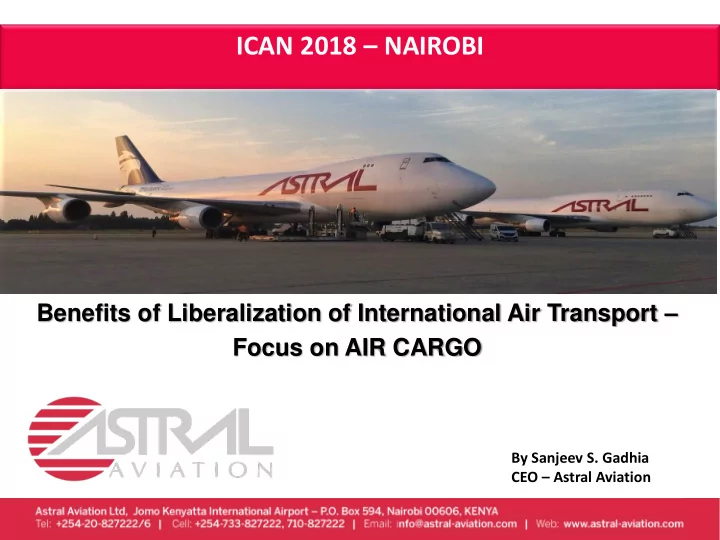

ICAN 2018 – NAIROBI Benefits of Liberalization of International Air Transport – Focus on AIR CARGO By Sanjeev S. Gadhia CEO – Astral Aviation
Who we are – What we do All-Cargo Airline, based at JKIA, Nairobi and operational for 18y. Designated a National Carrier - Cargo by MoT – Kenya Scheduled Freighter Ex Nairobi -: Europe > London Stansted, Doncaster & Liege, Belgium Intra-Africa > Tanzania (Dar, Mwanza, Zanzibar), Rwanda (Kigali), Somalia (Mogadishu & Hargeisa), S Sudan (Juba), Mozambique (Pemba & Nampula), Comoros (Moroni) Freighter Fleet -: B747-400F, B727F, DC9F, F27. (B737F, B767F & FlyOx*) Cooperation with 6 African Airlines / 14 Foreign Airlines Voted Best African All Cargo Airline in 2017, 2015, 2013 & 2011. Member of AFRAA & TIACA
NAIROBI – Premier Cargo Hub of Africa No 3 Cargo Airport in Africa (2017 – 273,623 tons / 2016 – 231,797 tons) Airport Infrastructure (Cargo Capacity Excess 1m Tons / 5 GHA’s) Liberal Policy on Traffic Rights 14 Foreign Cargo Airlines / Global Connectivity Perishable Volumes (Growth in Flower / Veg Exports) Humanitarian Corridor (South Sudan, Somalia, Yemen, D R Congo) Connectivity Options (via Astral Aviation, Kenya Airways & DHL) e-AWB (Rank 31 / No 2 – Africa / 65% - Sep 2018) Government of Kenya (SAATM, TFTA, PPP, CSQ)
AFRICA – Highest Growth in Air Cargo African carriers’ posted the fastest growth in year -on- year freight volumes, up 15.6% in December 2017 and a capacity increase of 7.9%. This contributed to an annual growth in freight demand of 24.8% in 2017 – the fastest growth rate of all regions. Demand has been boosted by very strong growth in Africa-Asia trade which increased by more than 64% in the first eleven months of 2017.
AIRCARGO IN AFRICA – CHALLENGES HIGH COST Jet Fuel, Cargo Handling, Freight Tax and Royalties. REGULATIONS Lack of Liberalization, Restrictions on Traffic Rights, Protectionism. Favouritism for Foreign Carriers Vs African Carriers. CONNECTIVITY Lack of Intra-African Connectivity results in air-cargoes being routed via Middle East and Europe. Lack of Co-operation between African Airlines hampers connectivity . INFRASTRUCTURE Lack of Basic infrastructure, Terminals, Parking & Capacity for Aircargo Encourage Private sector investments Via PPP Framework FOREIGN CARRIERS Lack of Co-operation with African carriers. Dominates 85% of Cargo and 80% of Passenger Traffic Granted 5 th Freedom Rights in several Key Routes
AN OVERVIEW OF SAATM SAATM will eliminate the need for separate bilateral air service agreements (BASAs) between individual countries. It promotes multilateralism for air transport in Africa, as envisaged under the YD, with a view to making the entire African aviation market a single market. Free exercise of 1st, 2nd, 3rd, 4th and 5th freedom traffic to Eligible Airlines Liberalized air tariffs + Unrestricted frequency and capacity; Full liberalization of cargo services The SAATM will be more successful when all stakeholders work together to actualize its objectives. Governments need to work closely with airlines and other aviation stake-holders to formulate, promote or implement policies that support air transport growth. Civil Aviation Authorities have the responsibility for maintaining minimum interim standards of safety and security as recommended by ICAO and their national laws. This will greatly accelerate airline cooperation and collaboration as all parties (particularly passengers) are assured of uniformity across the continent. African Airlines have a major role to play. SAATM will be able to deliver on its promise if airlines actually cooperate with one another and maximize their opportunities
AN OVERVIEW OF SAATM 27 countries are Signatories namely Benin, Burkina Faso, Botswana, Capo Verde, Central African Republic, Chad, Congo, Côte d’Ivoire, Egypt, Ethiopia, Gabon, Gambia, Ghana, Guinea Conakry, Kenya, Lesotho, Liberia, Mali, Mozambique, Niger, Nigeria, Rwanda, Sierra Leone, South Africa, Swaziland, Togo and Zimbabwe. (These countries represent over 80% of the existing aviation market in Africa) Non Signatories are Algeria, Angola , Burundi, Cameroon , D R Congo, Djibouti, Eq Guinea, Eritrea, Madagascar, Mauritania, Mauritius , Morocco , Sao Tome, Senegal , Seychelles, Somalia, Sudan , S Sudan, Tanzania, Tunisia, Uganda & Zambia !!!
Liberalization & its BENEFITS CONSUMER Lower Cost + New Routes / Frequencies + Connectivity. AIRLINES Increase in Profitability + Cooperation + New Markets + Connectivity. REGION Increase in Regional Trade + GDP Growth + Investment + Employment “Aviation is the business of freedom. The opportunities aviation creates to improve people’s lives are tremendous – especially in Africa. It is important that the industry is able to drive growth and connectivity in Africa by working in lock-step with government to achieve: • Competitive cost structures that enable growth, • Effective infrastructure that can accommodate growth, • Harmonized regulatory framework that opens markets and promotes growth • Well-skilled diverse workforce that can drive growth” IATA DG Alexandre de Juniac at AFRAA AGA
CONCLUSION Aviation has the potential to make an important contribution to economic growth and development within Africa. LIBERALIZATION brings benefits to consumers and airlines, and results in lower fares and better connectivity, which in turn stimulates new and additional traffic volumes, trade and investment, which propels economic growth and increase in employment. If African nations and airlines don’t fully embrace the SAATM for the benefit of Africa, then the continent, its people and its airlines are unlikely to reach their full potential. With the implementation of SAATM, intra- African connectivity will develop and there will be more growth opportunities for African airlines. As a result, aviation’s role as an economic driver will grow significantly. The goal of the SAATM is to strengthen Safety and Security oversight on the continent and promote a climate of cooperation among African carriers through partnerships, mergers and consortiums
Recommend
More recommend